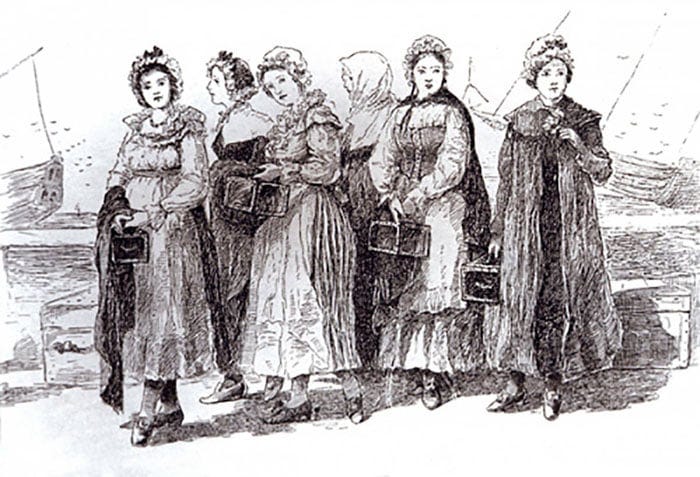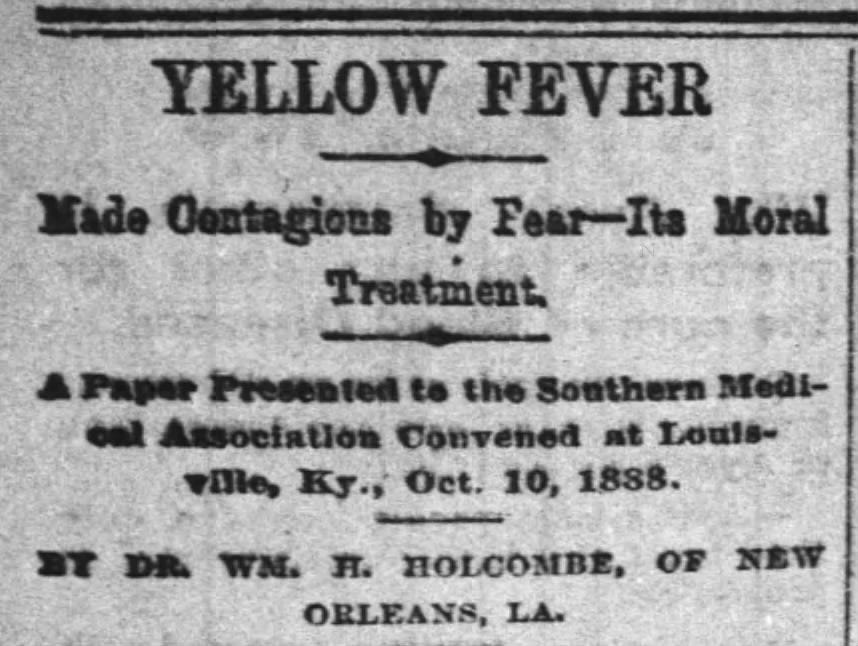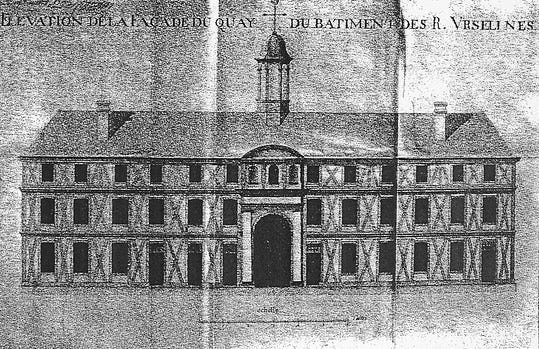The Casket Girls: From French Brides to Vampire Legends
or using local resources to research colonial ancestry (& vampires)
The legend goes that a group of young women were sent to Colonial New Orleans from France to help grow the French population in the New World, but when those women arrived, they were actually vampires.
It is a fanciful story told on late night haunted tours, showcased in Mardi Gras parades, and whispered about in movies, television, and novels. The young French women who came to the New World with caskets (or cassettes) that contained vampires (or dirt from their homeland). Most of the first wave of fille a la cassette arrived sickly. Once they passed, their coffin-shaped cases were kept on the third floor of the Ursuline Convent – the shutters secured with nails blessed by the pope.
Clearly, these women were merely couriers who also doubled as dinner for the vampires they brought to New Orleans or were vampires themselves, with boxes of homeland dirt to ensure their success in the new world.
Either legend you choose, this is how the legend of the Casket Girls began.
Alas, these young women were not vampires but the King's Daughters, sent by King Louis XIV to the French Colony of Louisiana to help populate the fledgling colony in America.
The King's Daughters, or "filles du roi" in French, were part of a program initiated by King Louis XIV of France to address the severe gender imbalance in the North American colonies. The program was initially used in New France or modern-day Canada between 1663 and 1673, where around 750-800 young women were sent to marry male settlers and help establish families. King Louis wanted to "feminize" the population and even offered the woman a dowry of 50 livers, which is around $4,000 today.
In Canada, none of these women were ever deemed vampires. Prostitutes? Yes. But vampires? No.
That legend began when the program was extended to the French colony on the Gulf of Mexico.

Due to the earlier success in New France, a similar program was implemented in Louisiana in the early 18th century. Some 250 young women, often from orphanages, convents, and prisons, were recruited from France and sent to New Orleans. Like before, they were given a dowry by the king and tasked with marrying colonists and starting French families in the new settlement.
These women were dubbed "casket girls," most likely due to the mistranslation of their French name - filles à la cassette – which translated to "women with small suitcases" during the era of their arrival. [In modern French - filles à la cassette translates to "girls on tape."]
In the 1720s, filles à la cassette, or women (filles) with small suitcases (cassettes) containing their clothes and personal belongings, arrived in New Orleans. But as they were released from captivity below deck (to ensure their purity) and stepped off the French ship and onto the shores of their new home, many were sickly from travel.
Four difficult months traveling the Atlantic aboard rat infested ships ravaged by diseases like scurvy and diphtheria left them worse for wear—if they survived the voyage. When the captain released their precious cargo from the bowels of the ship, the women were pale, some with bloody gums (due to scurvy), and the first whispers of them being vampires came from the crew.
The thought of landfall must have comforted the women, but they would quickly learn that life in the New World wasn't much better than the ship they left behind. New Orleans was rife with disease, as smallpox and yellow fever tore across America.
Seventy-five years after the arrival of the first Casket Girls, New Orleans was dubbed the "City of the Dead" or "Necropolis" due to frequent Yellow Fever outbreaks, in addition to pox, diphtheria, and scarlet fever.
The new arrivals were transported to Ursuline Convent, along with their tiny "casket" trunks, where many died. But their deaths and the sailors weren't what ultimately fueled the lore of them either being vampires or bringing vampires with them. The legend of the Casket Girls caught fire when mortality rates in the colony skyrocketed shortly after their arrival – notably infant mortality.
Rumors tore through parishes. The sudden deaths needed a person to blame – so fingers were pointed at the women newly arrived in the New World, and a legend of vampire women was born.
Are you related to vampires?
When researching your family history, brick walls, dead ends, and historical roadblocks are part of the experience. Researching the identities of the Casket Girls is no different, but that doesn't mean you should not try. So, if you've traced your family history back to colonial French America, here are a few resources to help you get started on learning if your 5x+ Great-Grandmother was, in fact, a filles à la cassette.
Archives Nationales d'outre-mer: "...archives from, on the one hand, ministries responsible for the XVIIth and XXth Centuries of the French colonial empire, and on the other hand from local administrations of former colonies and Algeria. It also describes additional resources (private archives, photographs, maps and plans, library, microfilmed archives)."
The Ursuline Convent Museum in New Orleans: While the museum doesn't have specific records about the Casket Girls, it offers a glimpse into the world they joined.
The Historic New Orleans Collection: A free museum in the heart of the French Quarter – it is also a research center that has both on-site and online resources. The Historic New Orleans Collection holds extensive records on early New Orleans history and offered off-site request help. (and a quarterly magazine with a lot of helpful information)
American-France Genealogical Society - Which offers a "members only" online library
While the story of French Vampire Women who traveled to the New World with their caskets filled with death is undoubtedly fascinating and an enduring tale, the true story of these brave young women is compelling and important. Without their sacrifice of being transported nearly 5,000 miles from the only home they ever knew, New Orleans wouldn't be the place it is today.
They left behind everything to build new lives in a strange land with people they'd never met. Their legacy is a crucial part of the formation of New Orleans' unique culture and heritage.
Whether you're interested in vampire lore or are attempting to prove you are a descendant of the supernatural tales attached to the King's Daughters, the Casket Girls will live on in the vampire lore surrounding the history of New Orleans.











The corollary of this story is that local women would not marry a newcomer to New Orleans unless he had endured a few years of Yellow Fever so that he was "acclimated" to the locale.
Excellent story and I did not know about this! Thank you for sharing.